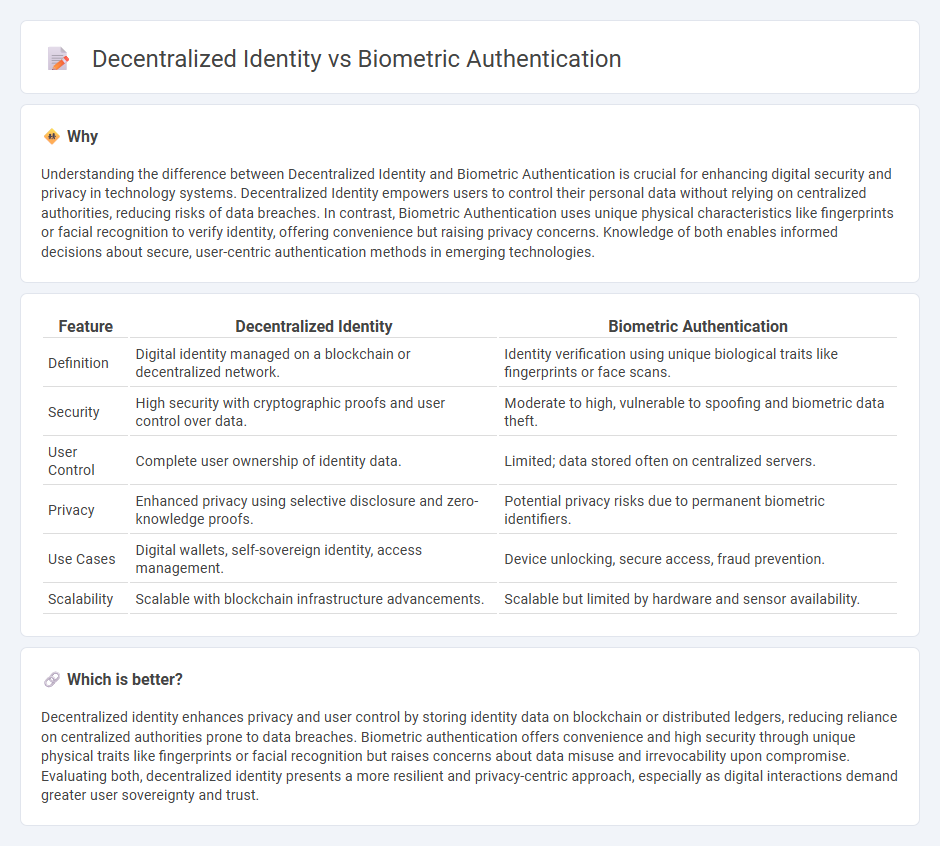
Decentralized identity leverages blockchain technology to give users control over their personal data by storing credentials on a distributed ledger, enhancing privacy and security. Biometric authentication relies on unique physical characteristics such as fingerprints or facial recognition to verify identity, offering convenience but raising concerns about data breaches and privacy. Explore the advantages and challenges of these identity verification methods to understand which technology is transforming digital security.
Why it is important
Understanding the difference between Decentralized Identity and Biometric Authentication is crucial for enhancing digital security and privacy in technology systems. Decentralized Identity empowers users to control their personal data without relying on centralized authorities, reducing risks of data breaches. In contrast, Biometric Authentication uses unique physical characteristics like fingerprints or facial recognition to verify identity, offering convenience but raising privacy concerns. Knowledge of both enables informed decisions about secure, user-centric authentication methods in emerging technologies.
Comparison Table
| Feature | Decentralized Identity | Biometric Authentication |
|---|---|---|
| Definition | Digital identity managed on a blockchain or decentralized network. | Identity verification using unique biological traits like fingerprints or face scans. |
| Security | High security with cryptographic proofs and user control over data. | Moderate to high, vulnerable to spoofing and biometric data theft. |
| User Control | Complete user ownership of identity data. | Limited; data stored often on centralized servers. |
| Privacy | Enhanced privacy using selective disclosure and zero-knowledge proofs. | Potential privacy risks due to permanent biometric identifiers. |
| Use Cases | Digital wallets, self-sovereign identity, access management. | Device unlocking, secure access, fraud prevention. |
| Scalability | Scalable with blockchain infrastructure advancements. | Scalable but limited by hardware and sensor availability. |
Which is better?
Decentralized identity enhances privacy and user control by storing identity data on blockchain or distributed ledgers, reducing reliance on centralized authorities prone to data breaches. Biometric authentication offers convenience and high security through unique physical traits like fingerprints or facial recognition but raises concerns about data misuse and irrevocability upon compromise. Evaluating both, decentralized identity presents a more resilient and privacy-centric approach, especially as digital interactions demand greater user sovereignty and trust.
Connection
Decentralized identity leverages blockchain technology to provide users control over their digital identities without relying on centralized authorities, enhancing privacy and security. Biometric authentication integrates with decentralized identity systems by using unique physiological traits, such as fingerprints or facial recognition, to verify user identity seamlessly and prevent fraud. This combination ensures a more robust, user-centric approach to identity management in digital ecosystems.
Key Terms
Fingerprint Recognition
Fingerprint recognition offers precise biometric authentication by analyzing unique friction ridge patterns, ensuring secure access control and identity verification. Decentralized identity leverages blockchain technology to allow individuals to control their identity data without relying on a central authority, enhancing privacy and reducing fraud risks. Discover more about how fingerprint recognition integrates with decentralized identity systems to revolutionize secure digital identity management.
Self-Sovereign Identity
Biometric authentication leverages unique physiological traits such as fingerprints or facial recognition to verify an individual's identity, enhancing security in digital interactions. Decentralized identity, particularly Self-Sovereign Identity (SSI), empowers users with full control over their personal data by leveraging blockchain technology and cryptographic proofs, reducing reliance on centralized authorities. Explore how biometric authentication integrates with decentralized frameworks to strengthen privacy and user autonomy in SSI ecosystems.
Blockchain
Biometric authentication leverages unique physiological traits such as fingerprints or facial recognition to verify identity, while decentralized identity employs blockchain technology to enable users to control and share their personal data securely without relying on centralized authorities. Blockchain enhances decentralized identity by providing a tamper-proof ledger, ensuring data integrity and privacy during identity verification processes. Discover more about how these technologies transform digital identity management and security.
Source and External Links
What is Biometric Authentication and How Does It Work? - Biometric authentication verifies identity using unique biological traits such as fingerprints, facial recognition, and iris scans, offering stronger security than traditional multi-factor authentication methods.
What is Biometric Authentication? Use Cases, Pros & Cons - Biometrics create unique models based on physical or behavioral traits to authenticate access, providing a more secure and convenient alternative to passwords that are vulnerable to theft and reuse.
Biometric Authentication: Good, Bad, & Ugly | OneLogin - While biometric systems can be vulnerable to spoofing, combining multiple biometric factors (multimodal authentication) and behavioral biometrics significantly reduces the risk of unauthorized access.
 dowidth.com
dowidth.com